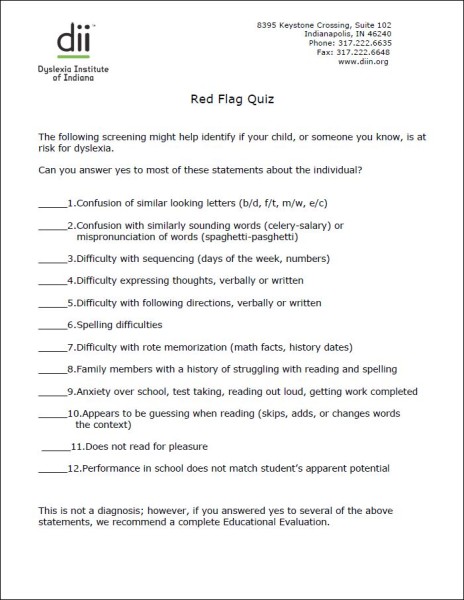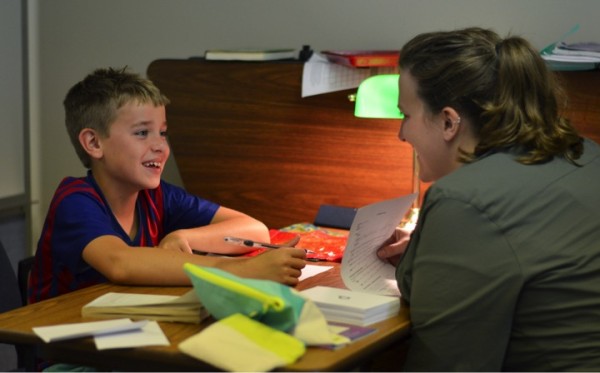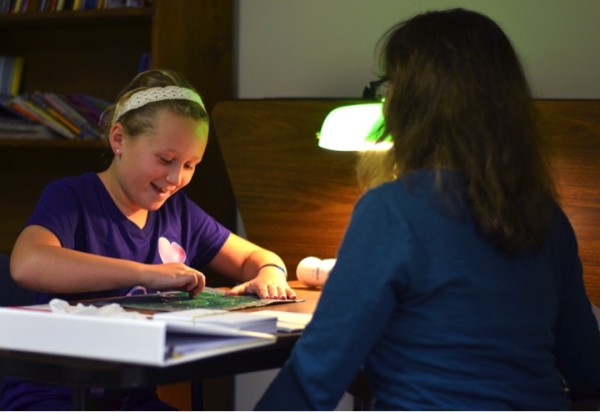Writer: Tiffany Whisner, Coles Marketing
 Do you have trouble telling the difference between “b” and “d,” or are you confused with words that sound similar, like celery and salary?
Do you have trouble telling the difference between “b” and “d,” or are you confused with words that sound similar, like celery and salary?
These are some of the “red flags” of dyslexia — a learning disability affecting about one in five people, or 20 percent of the population.
With so many people affected, there is definitely a need for specialized education so individuals with dyslexia can learn better. And as of July 1, 2015, there is now a mandate for teachers in Indiana to be trained for that education.
Grassroots to growing need
More than 25 years ago, a group of thoughtful parents came together to create a summer camp for their children with dyslexia. Today, Camp Delafield continues to provide a rigorous academic program and diverse arts and recreational program for children ages seven to 12 with dyslexia.
 Since then, the program has grown to include other camps, tutoring, teacher and parent training, testing services and support in the classroom throughout the school year — becoming the Dyslexia Institute of Indiana.
Since then, the program has grown to include other camps, tutoring, teacher and parent training, testing services and support in the classroom throughout the school year — becoming the Dyslexia Institute of Indiana.
Believing all people are entitled to fulfill their potential, the Dyslexia Institute of Indiana (DII) exists to serve children, adolescents and adults with dyslexia and specific language disabilities.
“Dyslexia is neurological in nature,” said DII CEO Nichole Freije. “These individuals are very smart and have a high IQ, but their reading ability doesn’t match their IQ — there’s a noticeable gap.” Freije joined DII last fall, having worked with many nonprofit and government clients and having a strong background in media and sponsorships. But it was a personal connection that drew her to DII.
“I have family members who have benefitted from the services offered at DII,” she said. “I was very aware of the organization from a customer or client standpoint. I have seen how important individual services are to those who have dyslexia, and I believe the DII approach is the right fit to enable them to overcome their unanticipated inability to read and really reach their full potential.”
Hard to say, harder to define
A specific learning disability, dyslexia is a disorder involving one’s understanding or use of language, spoken or written, that may also show itself in difficulties with listening, thinking, speaking, reading, writing, spelling or doing mathematical calculations.
“It’s so unique, and it shows up in a variety of different ways for different people,” Freije said. “There is a long list of possible signs of dyslexia, including the inversion of letters, difficulty with sequencing as in days of the week or hours of the day, or trouble with understanding instructions or directions.”
 Here is a look at the Red Flag Quiz from DII that might identify if someone is at risk for dyslexia. People with dyslexia may not necessarily even exhibit some typical characteristics.
Here is a look at the Red Flag Quiz from DII that might identify if someone is at risk for dyslexia. People with dyslexia may not necessarily even exhibit some typical characteristics.
Did you know some of these celebrities have been diagnosed with dyslexia? Henry Winkler. Whoopi Goldberg. Keira Knightley. Steven Spielberg. Patrick Dempsey. Anderson Cooper. Tim Tebow. Salma Hayek. Jay Leno. And the list goes on.
Because dyslexia is unique for each individual, parents and teachers both may not recognize the warning signs. That’s why it’s imperative to make sure resources and training are available to parents and teachers to give them the knowledge they need to be able to ask more questions and then get a referral for help.
And now that training has become law in the Hoosier state.
Legislation for learning
 House Bill 1108 went into law on July 1. It defines dyslexia as a specific learning disability and requires teacher training programs to prepare teachers to recognize a student who is not progressing at a normal rate related to reading may need to be referred to the school’s multidisciplinary team to determine the student’s special learning needs, including learning needs related to dyslexia.
House Bill 1108 went into law on July 1. It defines dyslexia as a specific learning disability and requires teacher training programs to prepare teachers to recognize a student who is not progressing at a normal rate related to reading may need to be referred to the school’s multidisciplinary team to determine the student’s special learning needs, including learning needs related to dyslexia.
“We are thrilled,” Freije said. “This law shines a light on dyslexia that hasn’t happened before. The very fact elected officials in Indiana are aware of dyslexia and have associated a definition with it, that’s a huge milestone for Indiana.” Prior to the law, some teachers who work with students every day may already have training and knowledge about the signs they need to look for with dyslexia. But many do not.
“This law focuses on the teachers who are still in college training and studying to become elementary education teachers,” she said. “It will help provide them with education about dyslexia and the resources needed to take the next step.”
The law provides that if an education service center offers in-service training or other teacher training programs, the education service center may offer courses for teachers on dyslexia characteristics and appropriate interventions. It gives DII the opportunity to help with early intervention, giving children with dyslexia the chance to do well and catch up to their peers more quickly.
 “Our job is to help parents and educators know what to look for and where to refer the students for additional help,” Freije added. The new state law is the first step in a series of steps to come.
“Our job is to help parents and educators know what to look for and where to refer the students for additional help,” Freije added. The new state law is the first step in a series of steps to come.
“The passing of this law is the culmination of many parents and officials working together,” Freije said. “One of our partners is the Indiana branch of Decoding Dyslexia, a grassroots movement of parents seeking to raise awareness about dyslexia. They had a big role in affecting this policy change. They worked with Indiana Senator Rodric Bray as well as House Rep. Woody Burton to get this passed.”
House Bill 1108 was authored by Rep. Woody Burton, and Senate Bill 304 was authored by Sen. Rodric Bray and Sen. Pete Miller. The Senate version of the bill “requires an individual who seeks to receive an initial practitioner’s license as an elementary school teacher to demonstrate proficiency in the recognition of specific learning disabilities related to reading, including dyslexia.”
“This piece of legislation addresses dyslexia and also helps in the first steps of addressing the needs of educators and parents of children with dyslexia,” Freije said. “It will make a big difference. I am certain there are teachers and professors who have been aware of and educated on dyslexia and the different multisensory approaches in teaching. But now this law will make sure that training happens.”
A multisensory approach
Since the new law only offers training for teachers in school right now, DII offers courses, workshops and open houses for current teachers who want to learn the early warning signs and how to effectively teach reading, spelling and math through a multisensory approach.
 The Orton-Gillingham Multisensory Approach is a structured, phonetically-based system which involves correctly learning the sounds of individual letters using a multisensory approach. Sounds are taught in isolation. Instruction uses the visual, auditory and tactile/kinesthetic sensory learning channels simultaneously. The approach practices reading, writing and spelling not as isolated subjects, but as different aspects of the language function.
The Orton-Gillingham Multisensory Approach is a structured, phonetically-based system which involves correctly learning the sounds of individual letters using a multisensory approach. Sounds are taught in isolation. Instruction uses the visual, auditory and tactile/kinesthetic sensory learning channels simultaneously. The approach practices reading, writing and spelling not as isolated subjects, but as different aspects of the language function.
“We also offer an overview on understanding dyslexia, reading readiness and multisensory classroom instruction as additional workshops,” Freije said. “We want to give as many educators as possible the tools to help them help their students live up to their potential.”
The DII School Support Program works with area schools to help students receive the extra instructional remediation they need to achieve their academic potential. This includes direct services for teachers, students and parents along with small group instruction.
If a student is struggling in school and the parent or teacher can’t figure out why, DII has services to get started, including a comprehensive psycho-educational evaluation as well as a dyslexia consultation. And then a specialized support system and training is discussed.
“The training therapy we offer at DII takes the gap between an individual’s IQ and reading ability and fills that gap,” Freije said. “Our approach helps to minimize fears, develop confidence, achieve results and celebrate that success.”
Helping others reach their potential
DII is partnering with INDATA for a full-day training focused on assistive technology for individuals with dyslexia on Friday, July 24.
 “We are starting out with an overview of dyslexia — it’s hard to say and even harder to define,” Freije said. “We will also discuss what to look for, including the Red Flag Quiz. And then we will launch into a simulation, a hands-on workshop so training participants can ‘walk in the shoes’ of someone with dyslexia. Attendees will experience what it’s like to read, write and be in a classroom with dyslexia. Hopefully they will feel a bit of what it’s like to know you’re smart but also know something is just not right.”
“We are starting out with an overview of dyslexia — it’s hard to say and even harder to define,” Freije said. “We will also discuss what to look for, including the Red Flag Quiz. And then we will launch into a simulation, a hands-on workshop so training participants can ‘walk in the shoes’ of someone with dyslexia. Attendees will experience what it’s like to read, write and be in a classroom with dyslexia. Hopefully they will feel a bit of what it’s like to know you’re smart but also know something is just not right.”
The training will consist of the overview as well as reading, writing and spelling simulations. It will be led by DII Training and School-Based Programs Manager Lynn Leonard. A Ball State graduate, Leonard has worked as a special education instructional aid for Washington Township Schools and taught as a classroom teacher for the IPS school system.
 “Lynn is a special education professional with more than 20 years of experience serving teachers, students and parents,” Freije said. “She has worked with special needs students in a variety of settings, including one-on-one tutoring, small group instruction and special education classrooms. Lynn has been a DII instructor for the past six years. During that time she has been, and continues to be, a tutor and trainer for adults with dyslexia.”
“Lynn is a special education professional with more than 20 years of experience serving teachers, students and parents,” Freije said. “She has worked with special needs students in a variety of settings, including one-on-one tutoring, small group instruction and special education classrooms. Lynn has been a DII instructor for the past six years. During that time she has been, and continues to be, a tutor and trainer for adults with dyslexia.”
The INDATA training will also offer a look at assistive technology useful to individuals with dyslexia. There are a number of different tools that can be helpful with reading and writing. One of those is a voice recognition pen.
“It’s important for someone with dyslexia to get their thoughts on paper without being worried about how to spell a certain word,” Freije said. “A student with dyslexia may have a large spoken vocabulary but when it comes to writing, those words might not transfer to the page. Voice technology is great for expressing those thoughts on paper.”
Reading pens and machines along with voice-activated computer software, apps and audiobooks can give individuals with dyslexia a way to save time and overcome issues they may have, such as slow note taking or unreadable handwriting. This technology allows them to demonstrate their knowledge in ways they may never have been able to.
 “We have a great partnership with INDATA,” Freije said. “We regularly donate computers, laptops, phones and other pieces of technology to them to be refurbished and used by others with disabilities. And they, in turn, are a valuable community service provider to us — promoting dyslexia awareness, recognizing it, helping to arm those with dyslexia with the right tools and resources and referring those who need additional help to DII. We are working together to help people with dyslexia and other disabilities to achieve their full potential and have the best quality of life possible.”
“We have a great partnership with INDATA,” Freije said. “We regularly donate computers, laptops, phones and other pieces of technology to them to be refurbished and used by others with disabilities. And they, in turn, are a valuable community service provider to us — promoting dyslexia awareness, recognizing it, helping to arm those with dyslexia with the right tools and resources and referring those who need additional help to DII. We are working together to help people with dyslexia and other disabilities to achieve their full potential and have the best quality of life possible.”
